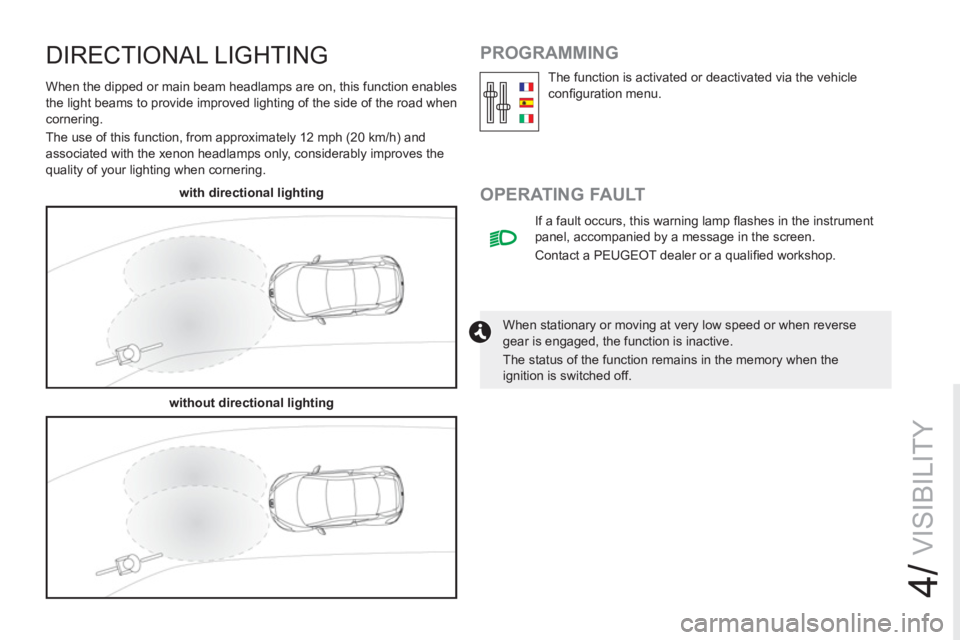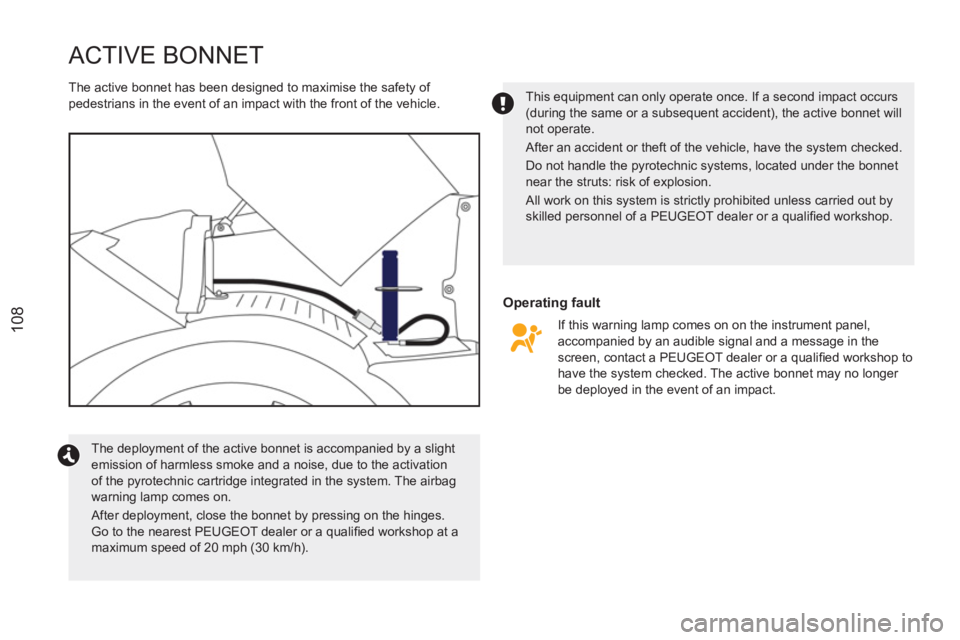2012 PEUGEOT RCZ warning light
[x] Cancel search: warning lightPage 91 of 336

3/
EASE OF USE and COMFORT
The duration of lighting varies, depending on the context:
- when the ignition is off, approximately ten minutes,
- in energy economy mode, approximately thirty seconds,
- when the engine is running, no limit.
STORAGE BOX
This has areas for storing a box of spare bulbs, a fi rst aid kit, the
temporary puncture repair kit, a warning triangle, the removable ball of
the towbar system...
BOOT LAMPS
Your vehicle is fi tted with two boot lamps; one in the right-hand boot
side trim and a second in the centre under the rear shelf.
They come on automatically when the boot is opened and switch off
automatically when the boot is closed.
They cannot be deactivated manually.
A second warning triangle can be stored in the boot lid trim. It also contains the vehicle's handbook pack.
For access to it:
�)
raise the fl oor using the strap,
�)
secure it in the vertical position behind the stops, located on the sides of the boot.
Page 97 of 336

4/
VISIBILITY
AUTOMATIC "GUIDE-ME-HOME" LIGHTING
Operating fault
In the event of a malfunction of the sunshine sensor, the
lighting comes on, this warning lamp is displayed in the
instrument panel and/or a message appears in the screen,
accompanied by an audible signal.
Contact a PEUGEOT dealer or a qualifi ed workshop.
In fog or snow, the sunshine sensor may detect suffi cient light. In
this case, the lighting will not come on automatically.
Do not cover the sunshine sensor, coupled with the rain sensor
and located in the centre of the windscreen behind the rear view
mirror; the associated functions would no longer be controlled.
When the automatic illumination of headlamps function is activated,
under low ambient light the dipped beams headlamps come on
automatically when the ignition is switched off.
Programming
Activation or deactivation, as well as the duration of the guide-me-home
lighting, is set in the vehicle confi guration menu.
Page 99 of 336

4/
VISIBILITY
DIRECTIONAL LIGHTING
When the dipped or main beam headlamps are on, this function enables
the light beams to provide improved lighting of the side of the road when
cornering.
The use of this function, from approximately 12 mph (20 km/h) and
associated with the xenon headlamps only, considerably improves the
quality of your lighting when cornering.
with directional lighting
without directional lighting
PROGRAMMING
OPERATING FAULT
When stationary or moving at very low speed or when reverse
gear is engaged, the function is inactive.
The status of the function remains in the memory when the
ignition is switched off. If a fault occurs, this warning lamp fl ashes in the instrument
panel, accompanied by a message in the screen.
Contact a PEUGEOT dealer or a qualifi ed workshop. The function is activated or deactivated via the vehicle
confi guration menu.
Page 104 of 336

102
DIRECTION INDICATORS
If you forget to cancel the direction indicators for more than
twenty seconds, the volume of the audible signal will increase if
the speed is above 40 mph (60 km/h).
�)
Left: lower the lighting stalk passing the point of resistance.
�)
Right: raise the lighting stalk passing the point of resistance.
HAZARD WARNING LAMPS
A visual warning by means of the direction indicators to alert other road
users to a vehicle breakdown, towing or accident.
�)
Press this button, the direction indicators fl ash.
They can operate with the ignition off.
AUTOMATIC OPERATION OF HAZARD
WARNING LAMPS
When braking in an emergency, depending on the deceleration, the
hazard warning lamps come on automatically.
They switch off automatically the fi rst time you accelerate.
�)
You can also switch them off by pressing the button.
Deactivating the ESC/ASR systems also deactivates the automatic
operation of the hazard warning lamps; refer to the "Trajectory control
systems - Deactivation" section.
Page 107 of 336

5/
SAFETY
BRAKING ASSISTA NCE SYSTEMS
Group of supplementary systems which help you to obtain optimum
braking in complete safety in emergency situations:
- anti-lock braking system (ABS),
- electronic brake force distribution (EBFD),
- emergency braking assistance (EBA).
ANTI-LOCK BRAKING SYSTEM AND
ELECTRONIC BRAKE FORCE DISTRIBUTION
Linked systems which improve the stability and manoeuvrability of your
vehicle when braking, in particular on poor or slippery surfaces.
Activation
The anti-lock braking system comes into operation automatically when
there is a risk of wheel lock.
Normal operation of the ABS may make itself felt by slight vibration of
the brake pedal.
When braking in an emergency, press very fi rmly without releasing
the pressure.
Operating fault
If this warning lamp comes on, accompanied by an audible
signal and a message in the screen, it indicates a malfunction
of the anti-lock braking system which could result in loss of
control of the vehicle when braking. If this warning lamp comes on, together with the STOP
and
ABS
warning lamps, accompanied by an audible signal and
a message in the screen, it indicates a malfunction of the
electronic brake force distribution which could result in loss of control of
the vehicle when braking.
You must stop as soon as it is safe to do so.
In either case, contact a PEUGEOT dealer or a qualifi ed workshop.
When replacing wheels (tyres and rims), ensure that they conform
to the manufacturer's recommendations.
When braking in an emergency, press fi rmly without releasing the
pressure.
EMERGENCY BRAKING ASSISTANCE
System which, in an emergency, enables you to obtain the optimum
braking pressure more quickly, thus reducing the stopping distance.
Activation
It is triggered by the speed at which the brake pedal is pressed.
The effect of this is a reduction in the resistance of the pedal and an
increase in braking effi ciency.
Page 110 of 336

108
ACTIVE BONNET
Operating fault
The active bonnet has been designed to maximise the safety of
pedestrians in the event of an impact with the front of the vehicle.
The deployment of the active bonnet is accompanied by a slight
emission of harmless smoke and a noise, due to the activation
of the pyrotechnic cartridge integrated in the system. The airbag
warning lamp comes on.
After deployment, close the bonnet by pressing on the hinges.
Go to the nearest PEUGEOT dealer or a qualifi ed workshop at a
maximum speed of 20 mph (30 km/h). This equipment can only operate once. If a second impact occurs
(during the same or a subsequent accident), the active bonnet will
not operate.
After an accident or theft of the vehicle, have the system checked.
Do not handle the pyrotechnic systems, located under the bonnet
near the struts: risk of explosion.
All work on this system is strictly prohibited unless carried out by
skilled personnel of a PEUGEOT dealer or a qualifi ed workshop.
If this warning lamp comes on on the instrument panel,
accompanied by an audible signal and a message in the
screen, contact a PEUGEOT dealer or a qualifi ed workshop to
have the system checked. The active bonnet may no longer
be deployed in the event of an impact.
Page 115 of 336

5/
SAFETY
The driver must ensure that passengers use the seat belts
correctly and that they are all restrained securely before
setting off.
Wherever you are seated in the vehicle, always fasten your seat
belt, even for short journeys.
Do not interchange the seat belt buckles as they will not fulfi l their
role fully.
The seat belts are fi tted with an inertia reel permitting automatic
adjustment of the length of the strap to your size. The seat belt is
stowed automatically when not in use.
Before and after use, ensure that the seat belt is reeled in
correctly.
The lower part of the strap must be positioned as low as possible
on the pelvis.
The upper part must be positioned in the hollow of the shoulder.
The inertia reels are fi tted with an automatic locking device which
comes into operation in the event of a collision, emergency
braking or if the vehicle rolls over. You can release the device by
pulling fi rmly on the strap and releasing it so that it reels in slightly.
In order to be effective, a seat belt must:
- be tightened as close to the body as possible,
- be pulled in front of you with a smooth movement, checking
that it does not twist,
- be used to restrain only one person,
- not bear any trace of cuts or fraying,
- not be converted or modifi ed to avoid affecting its
performance. In accordance with current safety regulations, for all repairs on your
vehicle, go to a qualifi ed workshop with the skills and equipment
needed, which a PEUGEOT dealer is able to provide.
Have your seat belts checked regularly by a PEUGEOT dealer or a
qualifi ed workshop, particularly if the straps show signs of damage.
Clean the seat belt straps with soapy water or a textile cleaning
product, sold by PEUGEOT dealers.
After folding or moving a seat or rear bench seat, ensure that the
seat belt is positioned and reeled in correctly.
Recommendations for children
Use a suitable child seat if the passenger is less than 12 years old or
shorter than one and a half metres.
Never use the same seat belt to secure more than one person.
Never allow a child to travel on your lap.
In the event of an impact
Depending on the nature and seriousness of the impact
, the
pretensioning device may be deployed before and independently
of the airbags. Deployment of the pretensioners is accompanied
by a slight discharge of harmless smoke and a noise, due to the
activation of the pyrotechnic cartridge incorporated in the system.
In all cases, the airbag warning lamp comes on.
Following an impact, have the seat belts system checked, and if
necessary replaced, by a PEUGEOT dealer or a qualifi ed workshop.
Page 129 of 336

6/
DRIVING
IGNITION SWITCH
ELECTRONIC ENGINE IMMOBILISER
STARTING THE VEHICLE
�)
Insert the key in the ignition switch.
The system recognises the starting code.
�)
Turn the key fully towards the dashboard to position 3 (Starting)
.
�)
When the engine starts, release the key.
SWITCHING THE VEHICLE OFF
�)
Immobilise the vehicle.
�)
Turn the key fully towards you to position 1 (Stop)
.
�)
Remove the key from the ignition switch.
Key left in the "Ignition on" position
On opening the driver's door, an alert message is displayed,
accompanied by an audible signal, to remind you that the key is
still in the ignition switch at position 1 (Stop)
.
If the key has been left in the ignition switch at position 2 (Ignition
on)
, the ignition will be switched off automatically after one hour.
To switch the ignition back on, turn the key to position 1 (Stop)
,
then back to position 2 (Ignition on)
.
The key contains an electronic chip which has a special code. When
the ignition is switched on, this code must be recognised in order for
starting to be possible.
A few minutes after the ignition is switched off, this electronic engine
immobiliser locks the engine management system and prevents starting
of the engine by anyone who does not have the key.
In the event of a malfunction, you are informed by lighting of this
warning lamp, an audible signal and a message on the screen.
In this case, your vehicle does not start; contact a PEUGEOT
dealer as soon as possible.